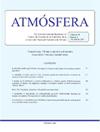Comparison of two air quality models in complex terrain near sea shore
IF 1
4区 地球科学
Q4 METEOROLOGY & ATMOSPHERIC SCIENCES
引用次数: 0
Abstract
Air pollution is the most important environmental problem in Zonguldak, Turkey due to excessive coal combustion and thermal power plant emissions. The city center is located on a complex terrain near the Black Sea shore. There exist some previous studies about PM10 pollution in the study area, but none of them is related to the spatial distribution of the pollutant. This air quality modeling study aims to fill this gap in the literature. Firstly, PM10 emission inventory has been prepared for point, line, and area sources for the year 2011. For that period, bituminous coal was the principal fuel for domestic heating in houses and generating electricity in thermal power plants, therefore particulate matter (PM10) was the leading air pollutant. Emission inventory calculations revealed that 2710.2 tons of PM10 have been emitted to the atmosphere from all sources in the study area. Then, the air quality modeling has been performed for PM10 by using two air quality models: AERMOD and CALPUFF. According to the modeling results, the PM10 pollution levels may pose a health threat to the inhabitants of Zonguldak. The maximum PM10 concentrations predicted by the CALPUFF model were higher than that of the AERMOD model. The model predicted values plus background concentration were validated against the PM10 measurements by using fractional bias, index of agreement, geometric mean bias, and geometric mean-variance. According to the model performance analysis, CALPUFF showed slightly better performance as compared to AERMOD.海岸附近复杂地形中两种空气质量模型的比较
空气污染是土耳其宗古尔达克最重要的环境问题,原因是煤炭过度燃烧和火力发电厂排放。市中心位于靠近黑海海岸的复杂地形上。研究区已有一些关于PM10污染的研究,但没有一项与污染物的空间分布有关。这项空气质量建模研究旨在填补文献中的这一空白。首先,编制了2011年点源、线源和面源PM10排放清单。在那个时期,烟煤是家庭供暖和火力发电厂发电的主要燃料,因此颗粒物(PM10)是主要的空气污染物。排放清单计算显示,研究区域内的所有来源向大气排放了2710.2吨PM10。然后,使用AERMOD和CALPUFF两个空气质量模型对PM10进行了空气质量建模。根据建模结果,PM10污染水平可能对宗古尔达克居民的健康构成威胁。CALPUFF模型预测的PM10最大浓度高于AERMOD模型。通过使用分数偏差、一致性指数、几何平均偏差和几何平均方差,对照PM10测量值验证了模型预测值加背景浓度。根据模型性能分析,与AERMOD相比,CALPUFF表现出略好的性能。
本文章由计算机程序翻译,如有差异,请以英文原文为准。
求助全文
约1分钟内获得全文
求助全文
来源期刊

Atmosfera
地学-气象与大气科学
CiteScore
2.20
自引率
0.00%
发文量
46
审稿时长
6 months
期刊介绍:
ATMÓSFERA seeks contributions on theoretical, basic, empirical and applied research in all the areas of atmospheric sciences, with emphasis on meteorology, climatology, aeronomy, physics, chemistry, and aerobiology. Interdisciplinary contributions are also accepted; especially those related with oceanography, hydrology, climate variability and change, ecology, forestry, glaciology, agriculture, environmental pollution, and other topics related to economy and society as they are affected by atmospheric hazards.
 求助内容:
求助内容: 应助结果提醒方式:
应助结果提醒方式:


